COVID-19: Review of Diagnostic Methods and Virus Spread Analysis
VerifiedAdded on 2022/09/15
|5
|977
|17
Report
AI Summary
This report analyzes a newspaper article concerning the COVID-19 pandemic, focusing on diagnostic methods and the ongoing debate regarding viral transmission. The article discusses the Centers for Disease Control and Prevention's (CDC) introduction of serological tests, such as rapid diagnostic tests (RDTs), and their limitations in providing quantifiable antibody data and varying development periods. It contrasts these with the nucleic acid amplification tests (NAAT), particularly the RT-PCR method, considered the gold standard for early detection of the virus. The report also examines the newspaper article's insights on airborne transmission, emphasizing the need for meticulous practices among nursing professionals, including careful handling of personal protective equipment and the potential use of face masks to reduce contamination. The report references articles from The Scientist, Johns Hopkins Center for Health Security, and the Paul-Ehrlich-Institut to support its findings.
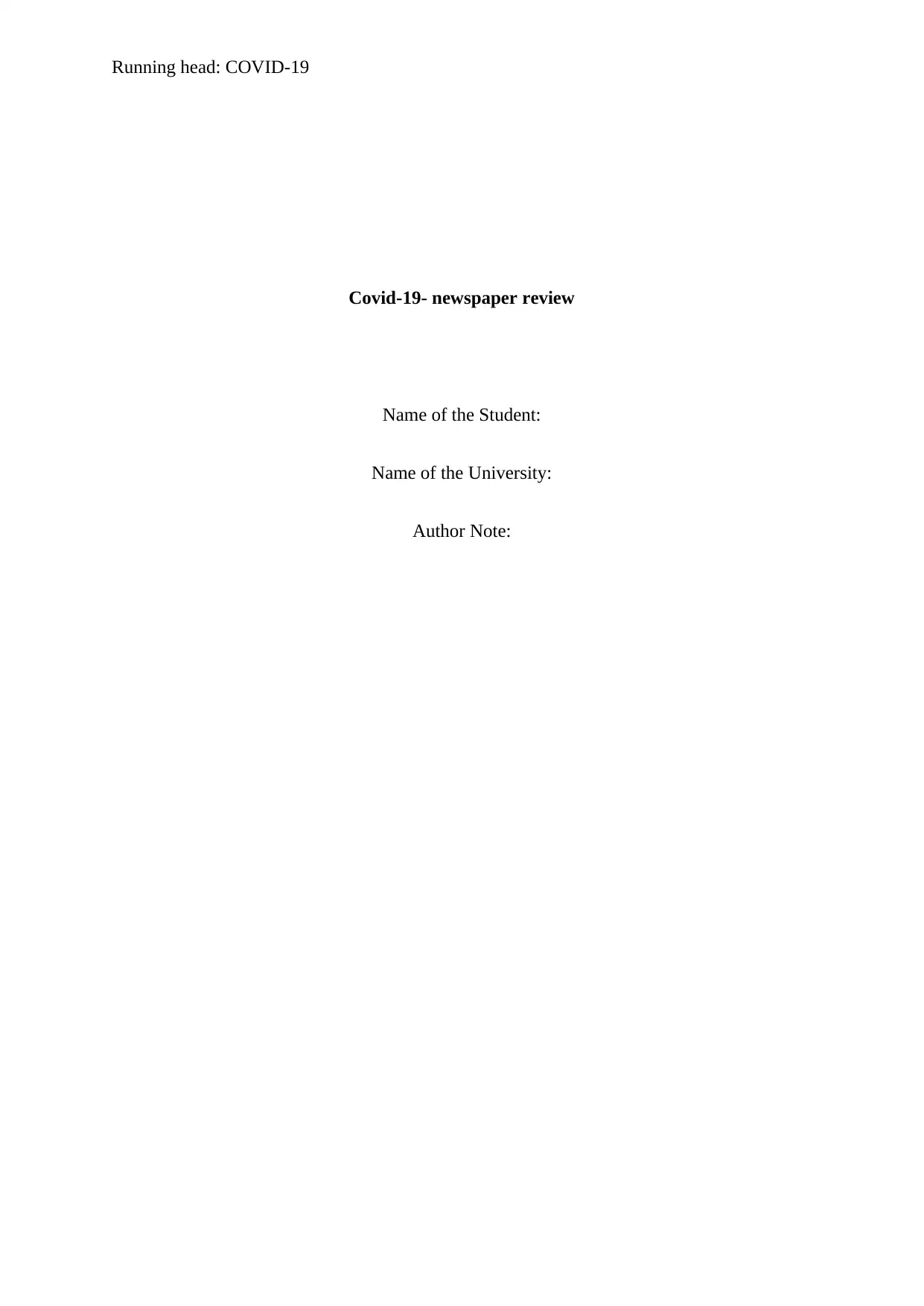
Running head: COVID-19
Covid-19- newspaper review
Name of the Student:
Name of the University:
Author Note:
Covid-19- newspaper review
Name of the Student:
Name of the University:
Author Note:
Paraphrase This Document
Need a fresh take? Get an instant paraphrase of this document with our AI Paraphraser
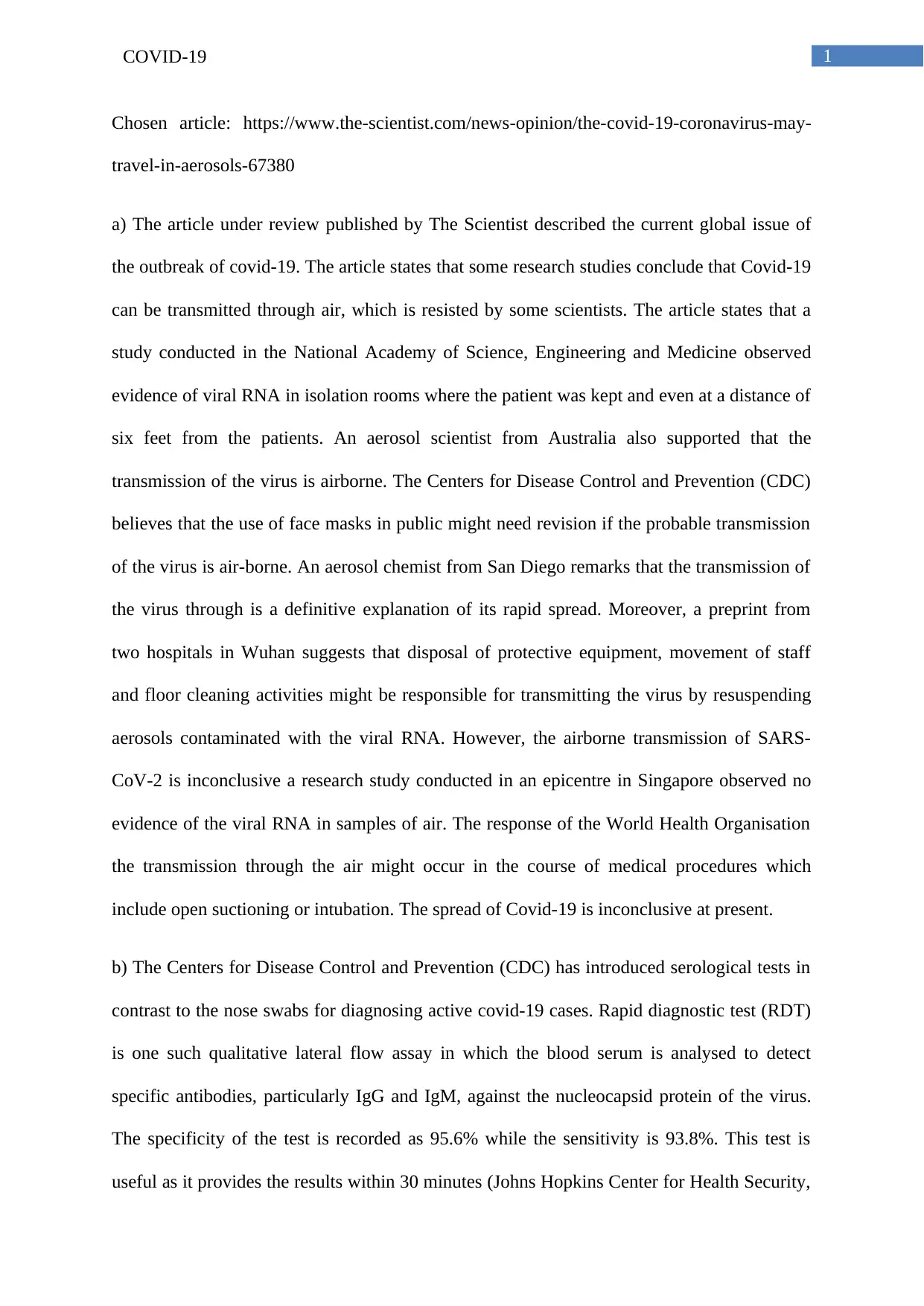
COVID-19 1
Chosen article: https://www.the-scientist.com/news-opinion/the-covid-19-coronavirus-may-
travel-in-aerosols-67380
a) The article under review published by The Scientist described the current global issue of
the outbreak of covid-19. The article states that some research studies conclude that Covid-19
can be transmitted through air, which is resisted by some scientists. The article states that a
study conducted in the National Academy of Science, Engineering and Medicine observed
evidence of viral RNA in isolation rooms where the patient was kept and even at a distance of
six feet from the patients. An aerosol scientist from Australia also supported that the
transmission of the virus is airborne. The Centers for Disease Control and Prevention (CDC)
believes that the use of face masks in public might need revision if the probable transmission
of the virus is air-borne. An aerosol chemist from San Diego remarks that the transmission of
the virus through is a definitive explanation of its rapid spread. Moreover, a preprint from
two hospitals in Wuhan suggests that disposal of protective equipment, movement of staff
and floor cleaning activities might be responsible for transmitting the virus by resuspending
aerosols contaminated with the viral RNA. However, the airborne transmission of SARS-
CoV-2 is inconclusive a research study conducted in an epicentre in Singapore observed no
evidence of the viral RNA in samples of air. The response of the World Health Organisation
the transmission through the air might occur in the course of medical procedures which
include open suctioning or intubation. The spread of Covid-19 is inconclusive at present.
b) The Centers for Disease Control and Prevention (CDC) has introduced serological tests in
contrast to the nose swabs for diagnosing active covid-19 cases. Rapid diagnostic test (RDT)
is one such qualitative lateral flow assay in which the blood serum is analysed to detect
specific antibodies, particularly IgG and IgM, against the nucleocapsid protein of the virus.
The specificity of the test is recorded as 95.6% while the sensitivity is 93.8%. This test is
useful as it provides the results within 30 minutes (Johns Hopkins Center for Health Security,
Chosen article: https://www.the-scientist.com/news-opinion/the-covid-19-coronavirus-may-
travel-in-aerosols-67380
a) The article under review published by The Scientist described the current global issue of
the outbreak of covid-19. The article states that some research studies conclude that Covid-19
can be transmitted through air, which is resisted by some scientists. The article states that a
study conducted in the National Academy of Science, Engineering and Medicine observed
evidence of viral RNA in isolation rooms where the patient was kept and even at a distance of
six feet from the patients. An aerosol scientist from Australia also supported that the
transmission of the virus is airborne. The Centers for Disease Control and Prevention (CDC)
believes that the use of face masks in public might need revision if the probable transmission
of the virus is air-borne. An aerosol chemist from San Diego remarks that the transmission of
the virus through is a definitive explanation of its rapid spread. Moreover, a preprint from
two hospitals in Wuhan suggests that disposal of protective equipment, movement of staff
and floor cleaning activities might be responsible for transmitting the virus by resuspending
aerosols contaminated with the viral RNA. However, the airborne transmission of SARS-
CoV-2 is inconclusive a research study conducted in an epicentre in Singapore observed no
evidence of the viral RNA in samples of air. The response of the World Health Organisation
the transmission through the air might occur in the course of medical procedures which
include open suctioning or intubation. The spread of Covid-19 is inconclusive at present.
b) The Centers for Disease Control and Prevention (CDC) has introduced serological tests in
contrast to the nose swabs for diagnosing active covid-19 cases. Rapid diagnostic test (RDT)
is one such qualitative lateral flow assay in which the blood serum is analysed to detect
specific antibodies, particularly IgG and IgM, against the nucleocapsid protein of the virus.
The specificity of the test is recorded as 95.6% while the sensitivity is 93.8%. This test is
useful as it provides the results within 30 minutes (Johns Hopkins Center for Health Security,
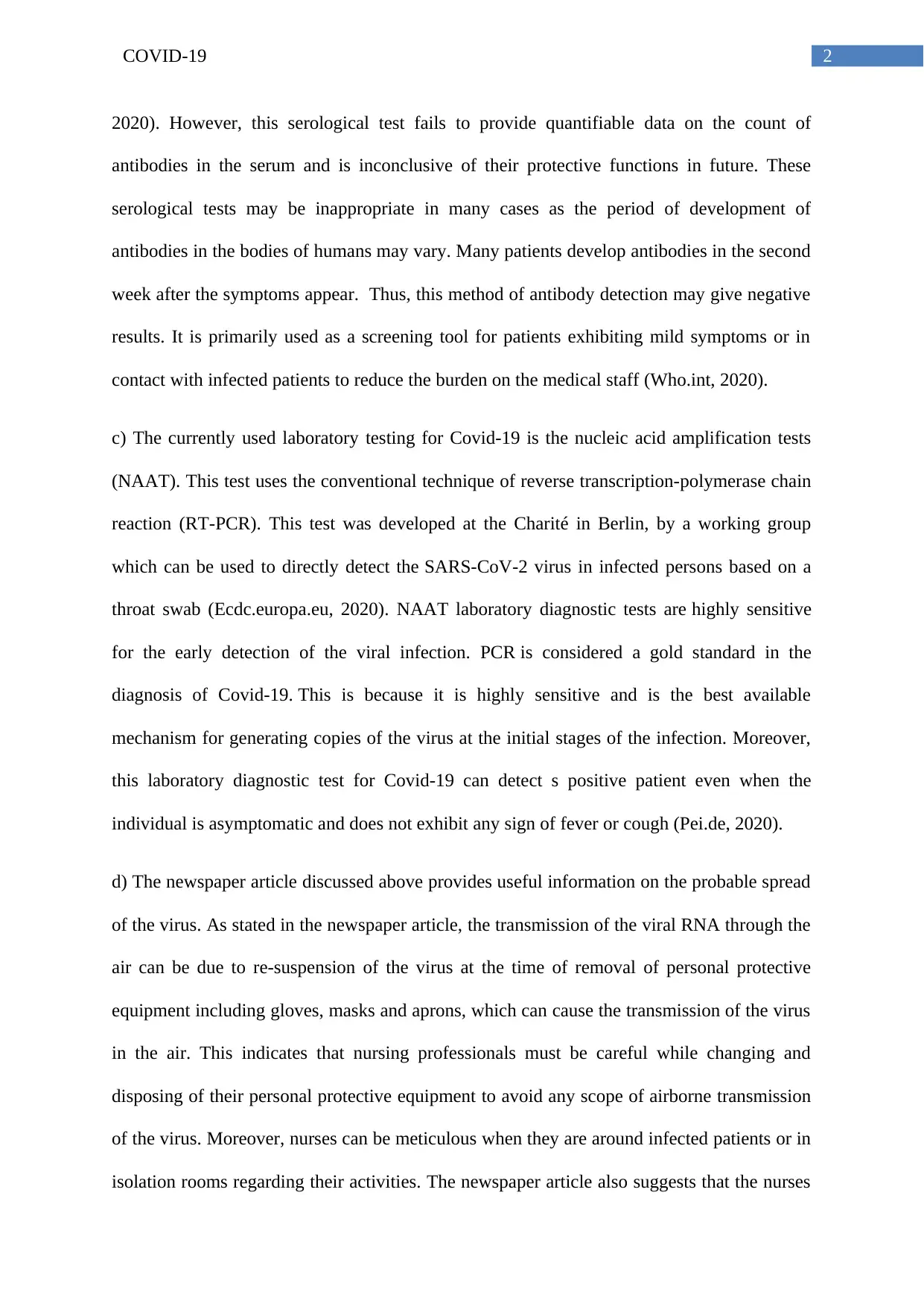
2COVID-19
2020). However, this serological test fails to provide quantifiable data on the count of
antibodies in the serum and is inconclusive of their protective functions in future. These
serological tests may be inappropriate in many cases as the period of development of
antibodies in the bodies of humans may vary. Many patients develop antibodies in the second
week after the symptoms appear. Thus, this method of antibody detection may give negative
results. It is primarily used as a screening tool for patients exhibiting mild symptoms or in
contact with infected patients to reduce the burden on the medical staff (Who.int, 2020).
c) The currently used laboratory testing for Covid-19 is the nucleic acid amplification tests
(NAAT). This test uses the conventional technique of reverse transcription-polymerase chain
reaction (RT-PCR). This test was developed at the Charité in Berlin, by a working group
which can be used to directly detect the SARS-CoV-2 virus in infected persons based on a
throat swab (Ecdc.europa.eu, 2020). NAAT laboratory diagnostic tests are highly sensitive
for the early detection of the viral infection. PCR is considered a gold standard in the
diagnosis of Covid-19. This is because it is highly sensitive and is the best available
mechanism for generating copies of the virus at the initial stages of the infection. Moreover,
this laboratory diagnostic test for Covid-19 can detect s positive patient even when the
individual is asymptomatic and does not exhibit any sign of fever or cough (Pei.de, 2020).
d) The newspaper article discussed above provides useful information on the probable spread
of the virus. As stated in the newspaper article, the transmission of the viral RNA through the
air can be due to re-suspension of the virus at the time of removal of personal protective
equipment including gloves, masks and aprons, which can cause the transmission of the virus
in the air. This indicates that nursing professionals must be careful while changing and
disposing of their personal protective equipment to avoid any scope of airborne transmission
of the virus. Moreover, nurses can be meticulous when they are around infected patients or in
isolation rooms regarding their activities. The newspaper article also suggests that the nurses
2020). However, this serological test fails to provide quantifiable data on the count of
antibodies in the serum and is inconclusive of their protective functions in future. These
serological tests may be inappropriate in many cases as the period of development of
antibodies in the bodies of humans may vary. Many patients develop antibodies in the second
week after the symptoms appear. Thus, this method of antibody detection may give negative
results. It is primarily used as a screening tool for patients exhibiting mild symptoms or in
contact with infected patients to reduce the burden on the medical staff (Who.int, 2020).
c) The currently used laboratory testing for Covid-19 is the nucleic acid amplification tests
(NAAT). This test uses the conventional technique of reverse transcription-polymerase chain
reaction (RT-PCR). This test was developed at the Charité in Berlin, by a working group
which can be used to directly detect the SARS-CoV-2 virus in infected persons based on a
throat swab (Ecdc.europa.eu, 2020). NAAT laboratory diagnostic tests are highly sensitive
for the early detection of the viral infection. PCR is considered a gold standard in the
diagnosis of Covid-19. This is because it is highly sensitive and is the best available
mechanism for generating copies of the virus at the initial stages of the infection. Moreover,
this laboratory diagnostic test for Covid-19 can detect s positive patient even when the
individual is asymptomatic and does not exhibit any sign of fever or cough (Pei.de, 2020).
d) The newspaper article discussed above provides useful information on the probable spread
of the virus. As stated in the newspaper article, the transmission of the viral RNA through the
air can be due to re-suspension of the virus at the time of removal of personal protective
equipment including gloves, masks and aprons, which can cause the transmission of the virus
in the air. This indicates that nursing professionals must be careful while changing and
disposing of their personal protective equipment to avoid any scope of airborne transmission
of the virus. Moreover, nurses can be meticulous when they are around infected patients or in
isolation rooms regarding their activities. The newspaper article also suggests that the nurses
⊘ This is a preview!⊘
Do you want full access?
Subscribe today to unlock all pages.

Trusted by 1+ million students worldwide
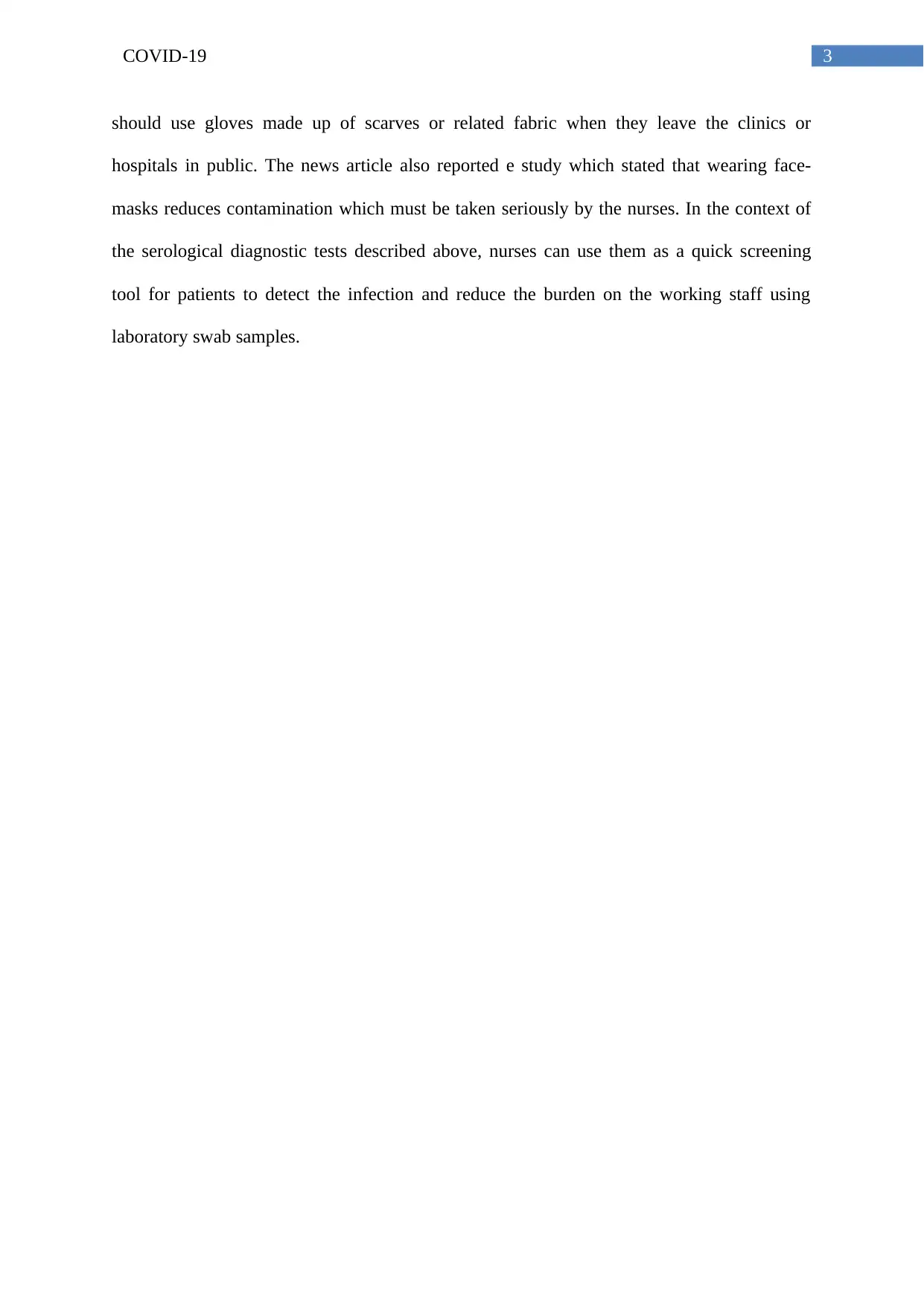
3COVID-19
should use gloves made up of scarves or related fabric when they leave the clinics or
hospitals in public. The news article also reported e study which stated that wearing face-
masks reduces contamination which must be taken seriously by the nurses. In the context of
the serological diagnostic tests described above, nurses can use them as a quick screening
tool for patients to detect the infection and reduce the burden on the working staff using
laboratory swab samples.
should use gloves made up of scarves or related fabric when they leave the clinics or
hospitals in public. The news article also reported e study which stated that wearing face-
masks reduces contamination which must be taken seriously by the nurses. In the context of
the serological diagnostic tests described above, nurses can use them as a quick screening
tool for patients to detect the infection and reduce the burden on the working staff using
laboratory swab samples.
Paraphrase This Document
Need a fresh take? Get an instant paraphrase of this document with our AI Paraphraser
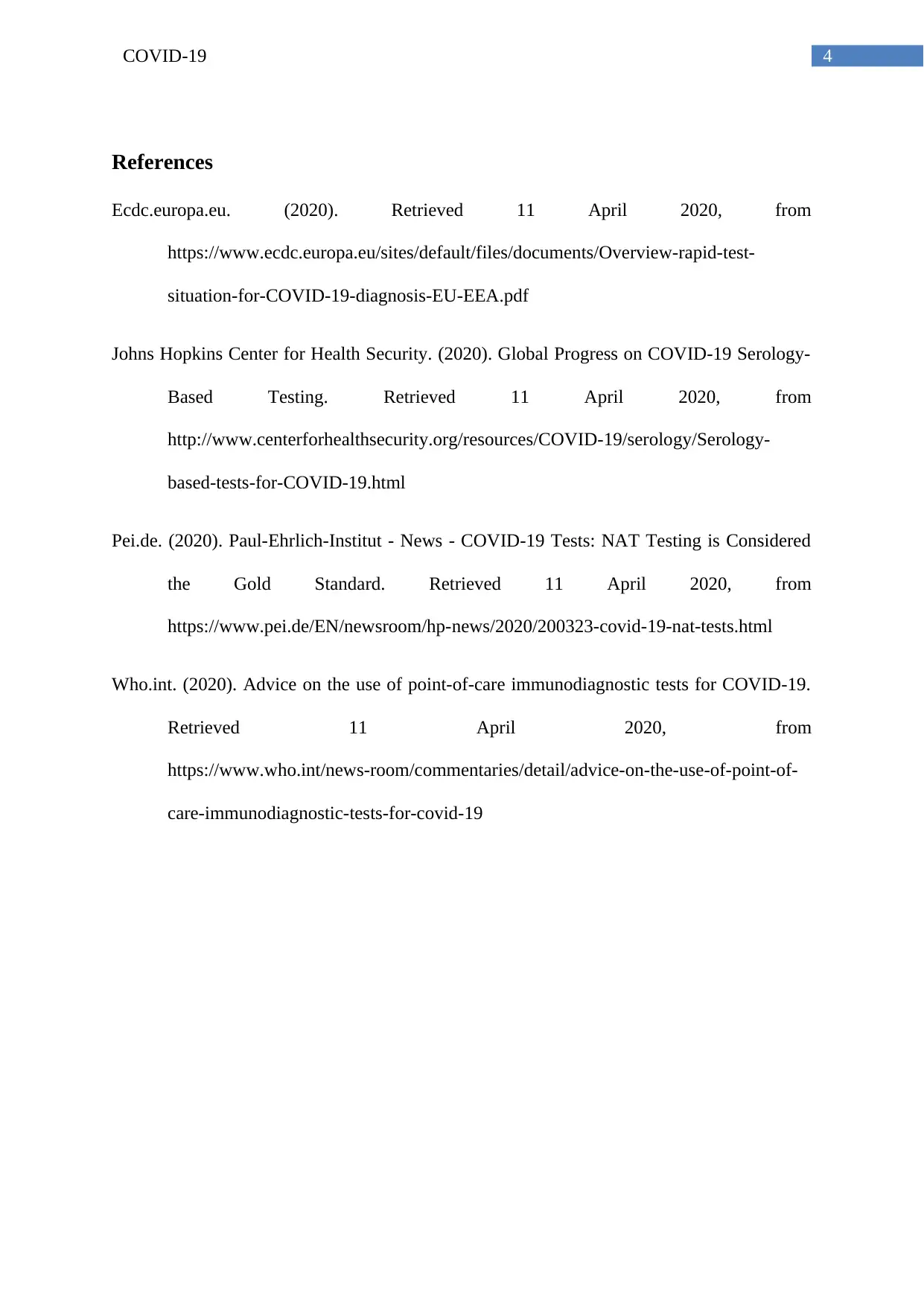
4COVID-19
References
Ecdc.europa.eu. (2020). Retrieved 11 April 2020, from
https://www.ecdc.europa.eu/sites/default/files/documents/Overview-rapid-test-
situation-for-COVID-19-diagnosis-EU-EEA.pdf
Johns Hopkins Center for Health Security. (2020). Global Progress on COVID-19 Serology-
Based Testing. Retrieved 11 April 2020, from
http://www.centerforhealthsecurity.org/resources/COVID-19/serology/Serology-
based-tests-for-COVID-19.html
Pei.de. (2020). Paul-Ehrlich-Institut - News - COVID-19 Tests: NAT Testing is Considered
the Gold Standard. Retrieved 11 April 2020, from
https://www.pei.de/EN/newsroom/hp-news/2020/200323-covid-19-nat-tests.html
Who.int. (2020). Advice on the use of point-of-care immunodiagnostic tests for COVID-19.
Retrieved 11 April 2020, from
https://www.who.int/news-room/commentaries/detail/advice-on-the-use-of-point-of-
care-immunodiagnostic-tests-for-covid-19
References
Ecdc.europa.eu. (2020). Retrieved 11 April 2020, from
https://www.ecdc.europa.eu/sites/default/files/documents/Overview-rapid-test-
situation-for-COVID-19-diagnosis-EU-EEA.pdf
Johns Hopkins Center for Health Security. (2020). Global Progress on COVID-19 Serology-
Based Testing. Retrieved 11 April 2020, from
http://www.centerforhealthsecurity.org/resources/COVID-19/serology/Serology-
based-tests-for-COVID-19.html
Pei.de. (2020). Paul-Ehrlich-Institut - News - COVID-19 Tests: NAT Testing is Considered
the Gold Standard. Retrieved 11 April 2020, from
https://www.pei.de/EN/newsroom/hp-news/2020/200323-covid-19-nat-tests.html
Who.int. (2020). Advice on the use of point-of-care immunodiagnostic tests for COVID-19.
Retrieved 11 April 2020, from
https://www.who.int/news-room/commentaries/detail/advice-on-the-use-of-point-of-
care-immunodiagnostic-tests-for-covid-19
1 out of 5
Your All-in-One AI-Powered Toolkit for Academic Success.
+13062052269
info@desklib.com
Available 24*7 on WhatsApp / Email
![[object Object]](/_next/static/media/star-bottom.7253800d.svg)
Unlock your academic potential
Copyright © 2020–2025 A2Z Services. All Rights Reserved. Developed and managed by ZUCOL.

